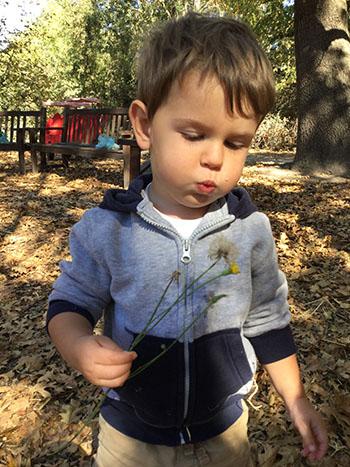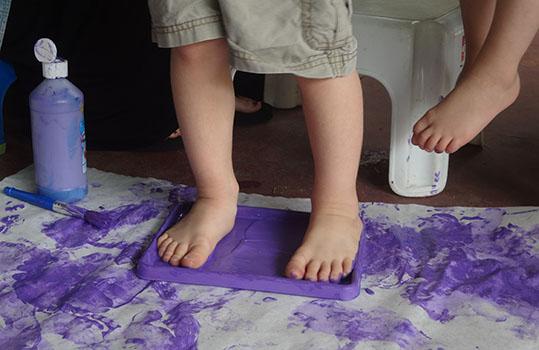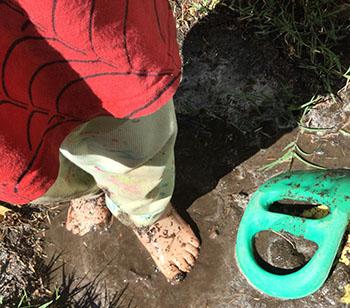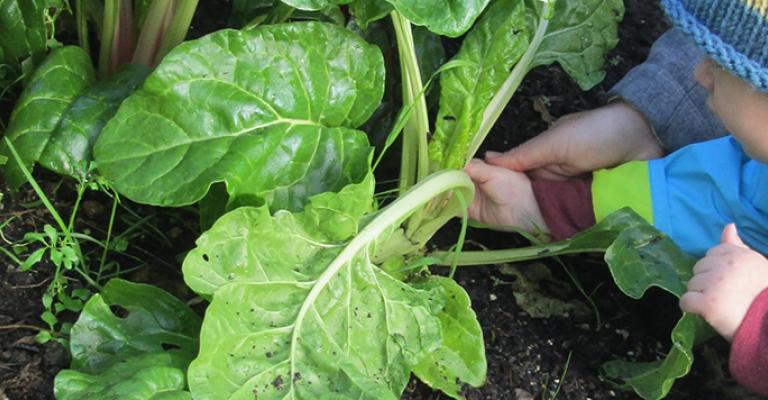Dandelion Environment

The Dandelion Environment is made up of students 2 to 3 years of age. This classroom is tailored specifically to the needs of the developing toddler, having transitioned from the Rosebuds classroom. The philosophy of Primary Care is continued in the Dandelions classroom, with a teacher assigned to a child to help them through their day. The Dandelions classroom focuses on the independence of the child, encouraging and assisting each child to care for themselves and the environment. The indoor and outdoor classrooms are equipped with developmentally appropriate materials that foster curiosity, creativity, and the development of physical, social, emotional, and cognitive skills. Toddlers are sensory learners and enjoy activities such as water, painting, play dough, and other tactile experiences. They use their whole body in their play, which means they love to climb, run, jump, and push objects around. Toddlers tend to be extremely social beings. They are in the stage of parallel play, but move in groups and enjoy being together. We encourage socialization and work with the children to learn how to be respectful, responsible, and resourceful.


Dandelion interests and curriculum include:
Cooking
In the Dandelion environment, we explore concepts such as taste, smell, and texture while cooking a wide variety of foods. The children learn about all of the steps of food preparation including harvesting, washing, cutting and prepping, and cooking. These explorations encourage children to develop fine motor skills, explore cause and effect, and learn all about their own bodies and personal food preferences. The Dandelions have helped to make smoothies with seasonal fruit, vegetable stir fries, and a variety of breads and muffins.
Gardening
The Dandelion love to explore the natural world around them by digging with spades, watering, planting seeds, and harvesting fruit and vegetables. The Dandelions are also fascinated with the chickens in the Children's School Community Garden. They feed and water the chickens, collect their eggs, and enjoy observing what the chickens like to eat. Dandelions are especially interested in the many creatures that live beneath the soil often searching for bugs and worms to hold and explore. These curriculum opportunities encourage knowledge of the natural world, fine and gross motor movement development, patience and persistence.
Building
One of the Dandelions' favorite areas in the classroom is the construction zone.they build with a wide variety of materials ranging from legos and beads to large, wooden blocks, pieces of fabric, and found natural materials. These activities help children to develop cognitive skills such as quantity, balance, shape, and size. They also encourage communication and social interaction with peers as children must work together to create large or elaborate constructions.
Home and School Connections
- Cook and eat with your Dandelion. Ask them what new foods they would like to try and actively involve them in the preparation process.
- Provide your Dandelion with a small space to grow plants at home. Help your child to take on the responsibility of watering and caring for plants. Discuss the changes you observe.
- Provide ample, open-ended materials for your children to build with. Encourage them to try out different techniques and work through frustrations if their structures fall.
Main Areas of Development; California Infant Toddler Early Learning Foundations and Desired Results Developmental Profile
From the California Infant Toddler Learning Foundations
- "Children can talk about their own wants and feelings and those of other people, describe familiar routines, participate in coordinated episodes of pretend play with peers, and interact with adults in more complex ways" (p. 33).
- "Children use a number of ways to solve problems: physically trying out possible solutions before finding out what works; using objects as tools; watching someone else solve the problem and then applying the same solution; or gesturing or vocalizing to someone else for help" (p.
| Approximate Times | Activities | What the Children Do |
|---|---|---|
| 7:30- 9:00 | Arrival | Children arrive at school Children will transition to school with help from parents and staff Children participate in self-selected play activities such as block play, dramatic play, table tops activities, etc. |
| 7:45-8:45 | Breakfast | Children will be invited to eat breakfast. |
| 8:30-11:30 | Activities Indoors and Outdoors | Children will self-select various play activities inside and out throughout the morning. Included in this time are a snack time and 2 diaper/toileting times. This is the time the Dandelions will go for walks around campus and care for the Community Garden. |
| 11:30 | Gathering Time | After a clean-up time, children gather together for stories, movement activities, and puppet play. |
| 11:45-12:15 | Lunch | Children wash up for lunch and eat a Childen's School family-style lunch |
| 12:15-3:00 | Naptime | After lunch, children will wash up, brush their teeth, find their nap place and begin their rest Children will look at books, use tabletop toys, etc. as they wake up and go outside. |
| 3:00-5:00 | Afternoon Play | Snack will be provided at 2:30. Children will self-select play activities inside or outdoors or both, help care for the outdoor environment, be assisted with diapering and toileting, and prepare for leaving the school based on their schedules |
5:00- 5:25 (School closes at 3:45 on Thursdays) | End of Day | All children will come inside Children will be offered a late, light snack, help clean up the inside of the classroom, and hear stories. |
5:30 3:45 on Thursdays | School Closes | Parents will greet children, gather their child’s things, check diaper supply, and depart |


